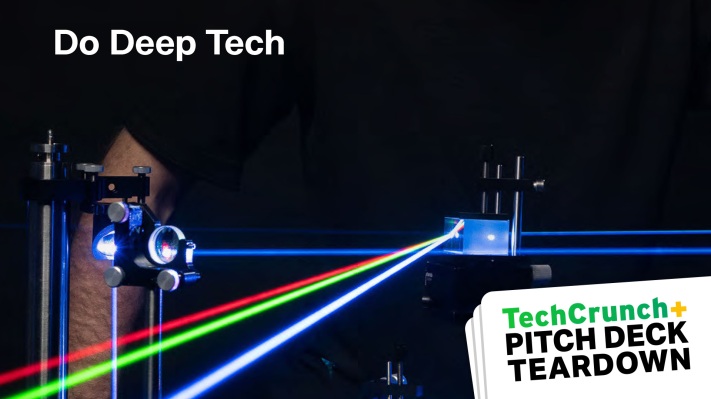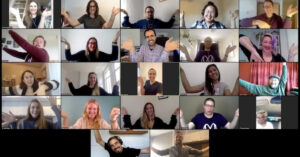We have quite a unique pitch deck on our hands today.
A few years ago, AR car hardware company WayRay raised $80 million at a half-a-billion valuation in a Series C round led by Porsche, and I’m super excited to show off their pitch deck today! Yes, it’s a little bit older than some of the decks we usually tear down, but it is rare that I get my hands on a 100% unedited, unabridged deck that resulted in a half-unicorn valuation.
WayRay’s deck consists of a whopping 75 slides — around 50 more than I would typically recommend for a deck like this — and it’s clear that the founders took a different tack than what we’re used to seeing these days. Nonetheless, you can’t argue with a successful fundraise of this caliber.
We’re looking for more unique pitch decks to tear down, so if you want to submit your own, here’s how you can do that.
Slides in the deck
Typically, I list all of the slides in a deck here so you can get an overview. But as I mentioned above, this deck contains 75 slides, and many of them aren’t particularly clear in terms of what they are actually for. Just flicking through the deck leaves me really confused in general, but I’ll get to why that’s a bad thing in a bit.
Let’s start by outlining what’s in the deck, and then take a look at how it all comes together, what works and what needs improvement.
- Cover slide
- “What makes us stand out” — USP slide
- Our Mission — Mission slide
- Graphic slide
- Past investor slide
- “Leadership in holography” — Platform description slide
- Cover slide — “Our Main Focus”
- “We believe that the car windshield is the most natural medium for delivering AR content.”
- Technology layers — Tech stack
- Technology layers — Tech implementation
- AR Marketplace — Example use case 1
- AR Marketplace — Example use case 2
- AR Marketplace — Example use case 3
- AR Marketplace — For the driver
- AR Marketplace — For the passenger
- Technology advantages
- “Advantages of WayRay’s AR HUD” product features slide
- “Technology comparison” — Compare head-up displays with competitors
- “Technology comparison” — Compare head-up displays with competitors
- “For us, conventional HUDs are no competition” — Positioning slide
- “Deep Reality Display” — Product overview slide
- “Conventional HUD” — Shows what the competition does
- “Breakthrough in Volume” — Shows how WayRay HUDs take up a smaller footprint in cars
- Cover slide — “Where we are now”
- “We are set up to sign commercial contracts” — Traction slide
- “True AR HUD: from the concept to commercialization” — Product roadmap slide
- “When introduced into a vehicle model” — Explains “stickiness” of the product between model years
- Business Model slide
- Cover slide — “How we work”
- Graphic slide: “Do Deep Tech”
- Graphic slide: “Do Deep Tech”
- “Vertical Integration” — Competitive advantage slide
- Graphic slide: “Holography”
- Graphic slide: “Holography”
- “Groundbreaking advancements in holography” — Tech overview
- Graphic slide: “Custom Lasers”
- “PGU optical design” — Shows how the HUD is designed
- “Advanced engineering techniques” — Shows how the products are designed
- “AR Rendering Engine” — Product slide
- “True AR SDK” — Third-party app developer slide
- Cover slide — “WayRay Overview”
- WayRay Team — Team slide 1
- WayRay Team — Team slide 2
- WayRay Team — Team slide 3
- WayRay Team — R&D departments org chart
- WayRay Team — Chemistry team slide
- WayRay Team — Design team slide
- WayRay Team — Electronics Engineering team slide
- WayRay Team — Hardware Engineering team slide
- WayRay Team — Optics & Holography team slide
- WayRay Team — Platform Solutions team slide
- WayRay Team — Quality Assurance team slide
- WayRay Team — Software Engineering slide
- WayRay Team — Swiss Technology Center team slide
- WayRay Labs — Laser Lab slide
- WayRay Labs — Holography Lab slide
- WayRay Labs — Experimental production slide
- WayRay Labs — PCB assembly facility slide
- WayRay Labs — Test lab slide
- WayRay Labs — CNC workshop slide
- WayRay Labs — Metrology equipment slide
- Cover slide — “Where we are headed”
- New Markets/Radical Innovations — Positioning slide
- Add-on holographic AR display — Future product slide
- “Application across multiple industries” — Go-to-market brainstorm
- Construction Equipment — Example use case slide
- “AR Side Window Solutions in trains” — Example use case slide
- “AR Side Window Solutions in Cabs” — Example use case slide
- “AR smart glass” — Example use case slide
- Awards — Awards received slide
- Events — CES 2017
- Events — CES 2018
- Events — CES Asia 2018
- Media Coverage slide
- Thank you slide
Three things to love
There’s a lot of incredible stuff to get my teeth into with these many slides. To start off, these slides have been designed extraordinarily well.
WayRay operates in the OEM car space. In other words, for its products to be seen out in the world, they have to be tested and accepted by car manufacturers, who then have to add the product to a future version of the car.
It’s a daunting prospect because these types of deals can drag on forever. I’ve worked with startups that have had to wait for more than a decade from their first conversations with a car manufacturer until the tech became available in a car you can buy. It stands to reason that such an endeavor is capital-intensive, but it also means that once you get over certain hurdles, you’re on a pretty clear path to market.
There’s evidence of both in this deck.
Super clear road map

[Slide 26] The WayRay road map shows its plans clearly. Image Credits: WayRay (opens in a new window)
I loved the way the company presents its plans and its milestones to date in a really simple road map (pun intended). The company draws a clear picture of where it is and what it is trying to do.
I would have a lot of questions about this timeline (a Q2 2022 RFQ to production in 2023 doesn’t seem realistic in my experience), but I do appreciate the clarity and the defined goals the company has set.
One of the deepest moats I’ve seen in a while

[Slide 32] Vertical integration all the way. Image Credits: WayRay
I often recommend young companies do only what is absolutely core to their business and outsource or use platforms for everything else. WayRay takes a different approach — it has in-house personnel for every aspect of its product development and manufacturing process.
The company specifically lists Optics and Holography, Hardware, Software and Electronics Engineering, Quality Assurance, Design and Chemistry. For some hardware companies, I wouldn’t have expected anything else, but in this case, it’s helpful to spell out that WayRay is taking quite a broad approach. Both here, and elsewhere in the deck, it becomes unwaveringly clear that the company has a real interest in, and penchant for, research and development.
WayRay does a great job at showing off the world it wants to live in.
Notably, the company doesn’t say if it has an army of IP lawyers making sure that its assets are protected. In fact, the word “patent” doesn’t appear anywhere in the pitch deck, which feels like an oversight.
Nonetheless, the company says: “The underlying intellectual property of our deep tech innovations is well-protected and hard to reproduce.” As an investor, I’d have loved to hear a bit more about how many patents the company is generating, in which parts of the world and how many patents have been approved.
Painting a picture of a very different world

[Slide 67] One thing the founders got very right: They help investors imagine a different world. Image Credits: WayRay (opens in a new window)
Being a founder is a lonely, wild journey into a future that you can see clearly but doesn’t exist yet. Storytelling is an important part of turning that story into reality, and WayRay does a great job at showing off the world it wants to live in.
This deck has a number of slides showing potential use cases — such as the augmented reality train window mockup above — like tourist destinations with overlays of roads and towns you might be seeing that add information. Is it necessary? Who knows. But it’s so cool that it makes me excited to imagine what it might be like to live in this world.
As a founder, if you’re able to inspire daydreams of the world you’re describing, you’re doing an incredible job. I wouldn’t be at all surprised if these visions — beautifully rendered and shown off throughout the pitch deck — are some great opportunities for that to happen.
In the rest of this teardown, we’ll look at three things WayRay could have improved or done differently, along with its full, 75-slide, unedited, unabridged pitch deck.
Three things that could be improved
Ho boy! OK, so let’s get this out of the way: 75 slides is way, way, way, way too many slides.
What’s worse, some of these slides make me wonder who they are for. It seems as if whoever put these slides together was really excited by the technology (and that’s wonderful), but then they shout about some of the wrong things from the rooftops, which throws the pitch off the track, somehow.










